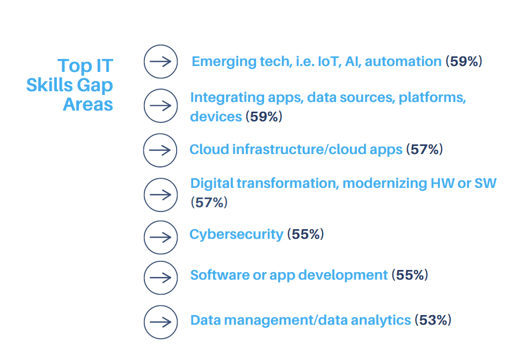From e-commerce and cloud computing to data mining and artificial intelligence, the global economy is becoming more and more dependent on digital technology. Today, information technology (IT) is an integral part of almost every job, and nearly every organisation relies on tech professionals to function effectively. However, as the tech industry progressively evolves into one of the fastest-growing industries globally, the challenges in IT recruitment are becoming more significant.

While the need for tech workers is at an all-time high, IT is always one of the key sectors mentioned whenever there is talk of skill and talent shortages. Companies are now facing severe issues in finding qualified candidates with the necessary technical abilities and ensuring they have the best tech talent. And although the competition for tech talent isn't new, combined with the ongoing economic and industrial changes, it is forcing business leaders to constantly navigate new recruiting landscapes and seek greater help from IT recruitment agencies.
Admittedly, when recruiting for tech positions, these are only the beginning of the recruitment challenges. In this article, Templeton's tech recruitment specialists present some of the most common challenges in recruiting IT talent, along with solutions and tips on overcoming them.
The Current State of the IT Marketplace
According to the latest data, 87% of employers and IT decision-makers say that they have trouble finding the tech talent they need. Further, an estimated 85 million jobs are expected to go unfilled globally by 2030 due to skills shortages. On top of these shortages and skill gaps, organisations are facing increasing pressure to innovate their way toward digital transformation. Now, the rate of IT adoption by companies has way surpassed the rate of available tech professionals, resulting in a competition for tech talent that is fiercer than ever.
Meanwhile, hiring managers and tech recruiters have to face a whole different set of problems, including having to deal with prolonged hiring processes, increased IT recruiting costs and higher employee demands.
Looking at the bright side, for every recruiting challenge, there is at least one solution for organisations and employers that understand that the only constant in IT recruitment is change and are willing to adapt. Ultimately, overcoming challenges in hiring tech talent is all about a little flexibility and implementing smart recruitment tactics.

Explore the Top 5 Hiring Trends for 2022: How HR Leaders Should Adapt
The Most Common Challenges of Hiring New IT Talent
If we had to ask a hundred different employers and the recruiters working with them to name their biggest hiring headache, we would probably receive a hundred different answers – depending on the size of the company or the type of roles they're hiring. However, most responses would probably gravitate towards a few common recruiting challenges.
Here are six of the top challenges business and tech leaders face when looking for IT professionals right now:
1. The Shortage of Available Tech Talent
As Industry 4.0 continues to play a more critical role in every aspect of living and working, the demand in the IT field is increasing quicker than the number of skilled and experienced tech professionals. This year alone, the IT industry has seen a record number of 7 million job openings. However, for every 100 new job openings in the IT field, there are only 65 qualified available candidates, and every year the number of tech job applications declines. Subsequently, this adds a lot of pressure on organisations to find the number of IT workers they need to deliver their services on time and with the right amount of expertise.
Meanwhile, the unemployment rate for IT workers remains historically low – just below 2% in April 2022, according to the latest CompTIA analysis. Undoubtedly, that's great news for tech job seekers but quite distressing for recruiters who have more jobs to fill than people with the skills and experience needed to fill them.
The demand is particularly strong for Software Developers and Engineers (which accounted for 30% of all job postings this year), along with IT Project Managers, IT Support Specialists, Systems Engineers and Architects, as well as Network Engineers and Architects.
Despite the great demand for tech experts, though, companies won't hire just anyone to fill those positions – they need professionals who have mastered essential skills such as big data and analytics, cyber security, AI and cloud computing, as well as programming languages like Python, C# and JavaScript. However, finding qualified talent with technical and professional knowledge in the field is the second biggest challenge in IT recruitment.
2. The Digital Skills Crisis
There are two main reasons why companies are struggling to find qualified tech candidates: The first is that there aren't enough IT professionals to keep up with increasing demands in the tech field. The second is related to the lack of requisite soft and tech skills, experience, and formal education. In fact, according to Nexford's data, 87% of businesses are either experiencing or anticipating experiencing a skills shortage within the next few years.
The world is facing a critical IT skill gap these days, and that doesn't strike as a surprise. For instance, by the end of 2022, a shortage of 70,000 IT or digital-related skills is projected in Sweden alone. Meanwhile, one of the world's three fastest-growing digital start-up nations, Israel, has a 15% software developer deficit. The global skills shortfall has already reached 40 million workers today, and by 2030 that number is expected to double.
Among the most probable industries to be affected by this growing digital skills crisis and IT talent shortage are data analytics, software development, and mobile and web design. However, without new qualified tech talent, business and digital transformation are difficult for companies across sectors. Organisations around the globe – most of them supporting almost 90% of their operations on the expertise of IT professionals – are now at risk of losing over $8.4 trillion in revenue due to the tech skills gap.

Emerging Tech professionals, Cyber Security specialists, and Data Scientists are only the beginning of a long list of critical tech skills that are in short supply. Tech recruiters and organisations are under tremendous pressure to find qualified talent as the demand and competition for skilled and experienced professionals have never been higher.
3. The Passive Pool of Tech Talent
The shortage of available tech talent and the increasingly wider digital skills gap negatively impact both product performance and innovation in organisations across sectors. For instance, a typical business will suffer decreased performance if it fails to find specialists to take on the senior-level and/or hard-to-fill vacancies.
However, recruiting can be tricky, especially if these vacancies include positions that require executive skills and a fair amount of experience – such candidates no longer enter the open market. In fact, according to a recent annual survey of Stack Overflow, only 15% of developers are actively looking for a job. Especially senior professionals and tech niche experts have so many incoming offers that they find it hard to keep track and react to all the incoming proposals (on average, an experienced senior front-end developer with a good background will see around 500 vacancies per week).
Hence, as qualified candidates in the IT industry are in short supply, HR specialists and tech recruiters are facing another major challenge: finding new ways to expand their potential talent pool, including recruiting passive candidates, who take up 75% of the general IT talent pool. And it can be even more challenging if employers are not willing to spend more on salary or offer more benefits and flexibility to attract and retain the already scarce high-quality candidates.
4. The Inefficient Recruiting Processes
When looking to hire a new employee, recruiters and hiring teams must consider so many different factors: keep recruitment costs low, hire fast, create an engaging candidate experience, find the right candidate for the position, and maintain a low candidate drop-off rate. All of these aspects of recruitment, however, come with their own set of challenges that, combined, can result in an inefficient recruitment process.
- Recruitment is expensive: Recruitment can be expensive, and it is no wonder why agencies and in-house teams are constantly searching for ways to reduce recruitment costs. In fact, a new hire could be as high as £30,000, according to an analysis from Oxford Economics. Most companies, though, tend to underestimate the cost of hiring by 90-95%, which can often lead to terrible decisions in recruiting.
- Recruitment is time-consuming: The time to hire is a key performance indicator for hiring teams, so it is surprising that only a mere 30% of companies can fill job openings within 30 days. The remaining take anywhere between one to four months to make a hire. But, in addition to increasing the cost per hire, taking too long to fill a role can also result in losing fast-moving (high-quality) candidates.
- Bad candidate experience: Candidates who have a positive and enjoyable recruitment experience are more likely to accept a job offer or refer their friends and peers to the company. On the contrary, too long or too complicated recruitment processes can turn into bad candidate experiences, which can limit a company's future talent pool and end up costing more time and money down the line.
- Higher turnover rates: In the past, employees would start working for a company and stay there until retirement. Nowadays, the culture around employment has shifted, with 60% of millennial candidates switching jobs every one or two years, according to a recent Gallup Particularly, tech's high turnover rate (13.2%) exceeds that of any other industry (10.5% average).
5. The Fierce Competition for the Best and the Brightest
As technology keeps evolving, so do companies. Not so long ago, hiring tech workers was something that concerned mostly companies within the IT industry. Today, organisations from all sectors rely on their digital expertise to some extent, and currently, there are more jobs available than IT job seekers. On top of that, the world of tech is facing a critical skills shortage, meaning that not all candidates are skilled and qualified to fill the available positions.
Therefore, companies are constantly finding themselves in the position of having to fight for top tech talent – and the competition for the best and the brightest is fierce. Applicants no longer have to take the first job they find: good candidates are contacted regularly by recruiters, while IT professionals with hard-to-find skills are often considering several job offers at the same time. According to a survey conducted by CodinGame, 25% of the tech recruiters surveyed said that the second biggest challenge they face in recruitment is standing out from other companies to attract and retain talent.
This means that employers and hiring teams need to put extra effort into persuading candidates to choose their company over competitors, often by offering higher salaries, more flexibility or other perks that will make their job offering more appealing. Moreover, employers are now spending more time and money on building their brands in an effort to get noticed by IT candidates. However, for companies with limited resources, spending more money on recruiting can't be a sustainable solution.

Find out What Do Candidates Want from Employers in 2022!
6. The Demand for Remote Work and Flexibility
Tech professionals know they are in high demand and therefore have the upper hand not only in salary and benefits negotiations but also in choosing how, when and where they want to do their job. Accelerated by the pandemic, remote working has given employees the "sweet taste" of freedom and flexibility to create their own working schedules and environment, and they are not willing to give them up.
According to recent surveys, more than three-quarters (79%) of tech workers want to continue working from home for the majority of the week after the pandemic. Today, approximately 40% of all digital workers are remote full-time and only 25% work exclusively in an office. The remaining 35% combines remote and office work. One step further, the idea of becoming a freelancer or independent contractor seems more attractive today for an increasing number of tech professionals.
For tech recruiters, this reality translates into an additional recruiting challenge: finding people that are willing to work on-site. But, IT professionals (more than any other group of workers) would be more willing to take a 10-20% pay cut to work remotely, give up some vacation time (21%) or even consider quitting their job if their employer required them to work from the office (44%), reveals the FlexJobs 10th Annual Survey.
Effective Solutions When Recruiting Tech Specialists
Recruiting IT candidates is challenging – the competition for skilled tech professionals is strong, and it's only going to get tougher as the demand for tech professionals continues to outpace the available supply. As the war for top talent rages on, employers and recruiters need to come up with more creative and efficient ways to attract and retain the best.
1. Get Noticed by the Right Candidates
In such a tight job market, full of unqualified tech talent, most companies will settle for the best person they can find at the time and not the best fit for the job. But it's not always about the quantity, but the quality of the candidates who apply. Most of the time, the best way to make the right hire is to have a smaller pipeline of more qualified talent.
To achieve that, companies and recruiters need to understand in depth what kind of candidates they want to attract, which skill sets they need for the position they want to fill and which personality traits would make an applicant a potentially good fit for their company culture. By having clear answers to these questions, you can search for talent in the right places, be more specific about the requirements in your job ads and reduce the time you spend on screening unfit candidates.
2. Explore More Diverse Talent Pools
Women, people of colour, individuals with disabilities, and candidates from the LGBTQ+ community hold a large portion of the tech talent pool, which is not feasible to ignore. But, in addition to having access to a wider talent pool, embracing diverse recruiting in tech can also benefit your business in various ways. Some of the many tangible benefits include better team performance, a broader range of skills and experiences, as well as increased innovation and productivity.
Moreover, fostering an authentically inclusive culture can help your company attract more potential employees. According to a Beqom survey, 48% of respondents said they would consider moving to another company if it had a well-developed Diversity, Equity and Inclusion (DEI) policy. This can be really important, especially for millennial candidates.
3. Reduce Recruitment Costs – Increase Efficiency
The truth is that bringing in the best and the brightest IT talent comes at a price. But not all businesses have the budget, and not all recruiters have the authority to put big money into expensive recruitment marketing campaigns or complicated talent acquisition strategies.
Still, you can count on more creative ways to reduce your recruitment costs whilst increasing the efficiency of your hire, including:
- Embracing remote recruiting: Virtual interviews can reduce the amount of time you spend recruiting new candidates – and hence costs.
- Getting the right talent in the first place: Recruiting is expensive, but imagine having to go through that process more than once.
- Introducing employee referral programmes: By implementing a referral scheme, you can save the money you would otherwise invest in job ads and marketing campaigns.
- Taking advantage of the social media benefits: Social media platforms are the most cost-efficient way to advertise your brand and post job ads.
- Reducing your time to hire: Keeping the hiring process short can minimise your cost per hire.

Interested in finding out more about how to calculate and reduce your recruitment costs? Check out our Recruitment Guide: How to Calculate Recruitment Costs & How to Reduce Recruitment Costs.
4. Hire Fast
Depending on the industry, making a hire can take up to several months. Long recruiting procedures, however, don't just increase the cost per hire but also the risk of losing high-quality candidates. So, in order to ensure the best talent doesn't get snapped up by rival businesses, employers – particularly in the world of tech – need to consider how they can make a hire as fast as possible.
Thankfully, there are several options to consider if you want to shorten your hiring processes, including cutting down recruiting stages by implementing the "two-stage rule" or investing in digital tools to streamline your applicant tracking process, such as an Applicant Tracking System (ATS).
5. Build a Strong Employer Brand
A strong employer brand can be really helpful in attracting and engaging top tech talent. In fact, statistics show that companies that have invested in employer branding are three times more likely to make a quality hire. Therefore, establishing a reputation as a preferred employer is crucial.
Part of this procedure involves everything from promoting the career progression opportunities you offer and your cutting-edge technology capabilities to showcasing your workplace culture on social media and answering online reviews. Additional benefits, such as flexibility, remote or hybrid working options, extra perks and performance-based bonuses, can also be the differentiating factor between candidates choosing one organisation over another.
6. Ensure a Good Candidate Experience
A positive candidate experience isn't just important for employer branding, but it is also an important factor for candidates when evaluating your job offer, as it often reflects their experience as employees in your company. Therefore, if they have a bad experience, they are less likely to accept it.
To increase your chances of success, effective communication is key. Starting from the early stages of recruiting, hiring managers should establish a positive connection with applicants to maintain a low candidate drop-off rate. By keeping communication lines open and setting clear expectations for the interview and the role, you can reduce your hiring problems and gain the trust of your potential employees. In the meantime, you can keep the pipeline engaged with innovative employer branding materials.
7. Engage Past and Passive Candidates
Did you know that your pipelines get stronger if you stay in touch with your past and passive candidates? Even if they are already employed and not actively looking for a new role, knowing that you are considering them automatically leaves the door open for them when they're finally ready for a change.
Additionally, by keeping the communication channels open, you can slowly build rapport on what they are interested in and what would encourage them to make the next move in their careers. So don't hesitate to reach out to passive and past candidates, either via in-person meetings or by sending them useful content and information.
8. Make More Appealing Job Offers
Throwing money at a recruitment challenge rarely is the answer, but competitive compensation for those who have the right qualifications is a must. So, when recruiting high-quality tech specialist skills, you need to keep in mind that they come at a price.
However, even if you can't afford to raise wages, you can still attract top talent with better benefits packages. In fact, according to Glassdoor, 80% of employees would prefer additional benefits over a pay increase. And you can really get creative about what you offer, from basic health care benefits to paid leave, future growth opportunities, additional time off, flexible schedules, and other affordable perks that provide a better overall experience to future employees.
9. Consider Freelancers and Contractors for the Role
It is common knowledge by now that filling tech-related vacancies are difficult due to a limited pool of talent across the industry. Even if you find a potential candidate, they may not possess the necessary skill set that matches your business's needs, goals, and vision. At the same time, more and more IT professionals are considering freelancing or contracting as an attractive career turn.
So, getting comfortable with the idea of hiring a freelancer or an independent contractor might be the answer to addressing talent and skills shortages – even if it's just a temporary solution. Plus, freelancers and contractors mainly work remotely, which opens up opportunities to find highly skilled talent not just within your region but on a broader scale and widen your candidate pool by hiring globally. However, remote working is not without its challenges, but technology increasingly allows communication, collaboration, relationship building, and knowledge-sharing solutions.
.jpg?width=9504&name=krakenimages-376KN_ISplE-unsplash(1).jpg)
Overcoming Tech Recruitment Challenges with Templeton
While there are a few things you can do to position yourself among the most attractive companies to work for, today's market continues to become more challenging and competitive when it comes to recruiting top IT talent: it's tough to find candidates who have the perfect mix of skills and experience, and it's even harder keeping up with their increasing demands to retain them.
But our tech recruitment specialists are up for the challenge. Templeton holds a 26-year track record of recruiting thousands of IT professionals around the globe and a vast database filled with potential candidates that suit your needs. Find out more about our multi-award-winning recruitment services.
Do you know Which Recruitment Model Is Best for You? Find out and gain a competitive advantage over your competitors.




